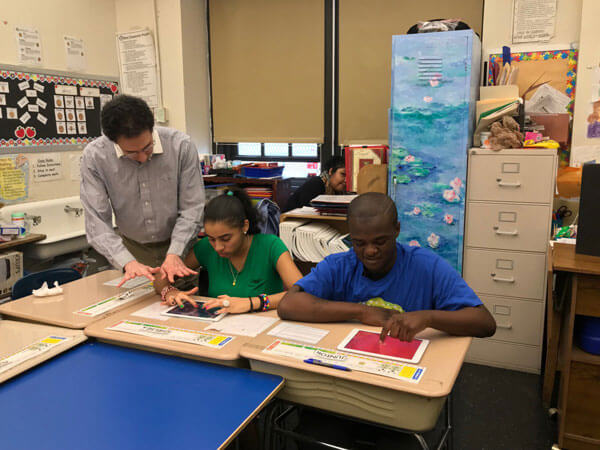By Tammy Scileppi
Music is an amazing and powerful teaching tool. It can be used to empower students as music makers, while creating a joyful connection that always puts smiles on their faces.
But it takes an extraordinary person, someone who is patient and compassionate, to ignite a spark in kids and teens with autism spectrum disorder and other special challenges, through the power of music.
Adam Goldberg, a music teacher at PS 177Q in Fresh Meadows, had an aha! moment when he discovered a remarkable way to better connect with his students via a unique method that he developed — using the hidden magic of iPads — to help them play musical “instruments.”
Eureka! It turned out that an Apple iPad could have transformative powers when used creatively in special education.
“When the iPad first came out, I could see immediately that they could be used to support my students’ music making,” said Goldberg, who started teaching with iPads in early 2011 but acknowledged that previously, he wasn’t into technology.
As a coverage teacher, he sees 120 to 150 special-needs students per semester, mostly from Queens. Each class has six to 12 students, and the age range is 8 to 21 years.
“My students are truly amongst the most wonderful humans on the planet. I want to provide authentic music-making opportunities to every student I serve,” Goldberg said.
“Music is a powerful means of self-expression, especially for my students, who may have difficulty expressing themselves in traditional ways,” he said. “The iPad and the growing list of peripheral devices that can be used in conjunction with it” — like the Skoog, a customizable musical instrument created for people with disabilities, and Roli Blocks, a new-age music-making device — “provide a means for me to universally design the music-making experience, so that every student has access to viable opportunities to express themselves musically within an ensemble setting.”
His talented students also play real musical instruments like keyboards, drums and percussion, and they sing, as well.
So why is it easier to teach on iPads?
“The iPad and the many highly modifiable music performance apps offer multiple entry points for students of all abilities,” Goldberg said. “Modifications can include the use of colors and lights, and the ability to select only those notes the student plays on the GUI” — the graphical user interface..
Music is a unique window into the world of autism, so kids, teens and young adults on the spectrum do better across the board when they’re musically engaged and playing instruments. There is evidence to suggest that many people with ASD can understand simple and complex musical emotions, despite limited socialization and communication skills.
Goldberg pointed out that in many ways, music serves as a foundation for communication and camaraderie among him and his students. “The accessibility of the iPad gives us a musical platform with which to communicate,” he noted.
And his students are quite proud of their accomplishments, while their parents are awed by how far they’ve come and are singing the praises of their favorite music teacher.
“It is one of my greatest joys to know that the parents can come to see their children perform together with their peers in schoolwide shows,” Goldberg said. “This is something that many parents don’t think their children could ever do. And yet some come forward to shine like stars. It can be very emotionally rewarding for them to see their children as featured performers on stage.”
This diverse group of musical stars has been performing for school shows and functions several times a year, and their popularity has grown. A while back, a Technology Band was formed, and students rocked out holiday tunes, as well as Bob Marley’s “One Love,” on their tablets.
They’ve been featured at education conferences, such as the Art for All Abilities Consortium’s annual conference at the Museum of Jewish Heritage in Manhattan and the UFT spring conference at the New York Hilton.
They’ve wowed audiences at two Manhattan Apple Stores, and even put on a concert in Washington, D.C. to open the U.S. Department of Education’s International Education Week in 2014.
“As a group, they have also very successfully ventured into composition,” Goldberg said. Their song “Take a Stand” will be performed at Carnegie Hall in March and at the school’s Black History Month show at the end of February.
Since music is a universal language, it’s easy to understand how it can break through any perceived boundaries and how it has brought out the best in Goldberg’s students.
He says it relaxes them and gets them prepared to focus and learn. “I can focus on the optimal qualities of music making, such as listening to each other, and expressing themselves within the structure of the musical context. Along with the way, iPad apps are modified for each student’s ability. The structure of the music — beat, rhythm, harmony and melody — provides both the guidelines and impetus for student progress, both as music makers and as young people who are developing sharper motor and cognitive skills, which help the student’s overall learning abilities.”
Having taught at PS 177Q for 25 years, Goldberg said, he finds that teaching music was far more challenging before he discovered iPads, which he was able to get thanks to a grant through his district.
“Music still served as a powerful way for me to reach students, and I did whatever modifications I could of more traditional instruments,” he noted.
While he says there are other iPad ensembles out there, and teachers using technology in their music classrooms, as a whole, he thinks music in schools is not nearly inclusive enough.
Goldberg said he gets many questions from people across the country, and around the world, on how to incorporate technology in their ensembles, but those questions represent a small minority. “Unfortunately, these powerful new technologies, and the many ways they can be used to include everyone in viable, expressive and successful music making, is slow to catch on at this point.”
When asked why he enjoys his work despite the challenges, PS 177Q’s numero uno music teacher replied: “In a sense, it’s the challenges that make my work so rewarding. My students are very good-hearted young people. They often don’t realize what they are capable of. When I witness their expressions of joy when they discover their ability to play music, it brings me great joy.
“And possibly the most valuable outcome of music making is the social skills that are developed whenever a group of students learns to play music together. They go through the process of learning together, and they all realize the value of their contribution, and how it amounts to something even more powerful than themselves when done together with their peers.”





































